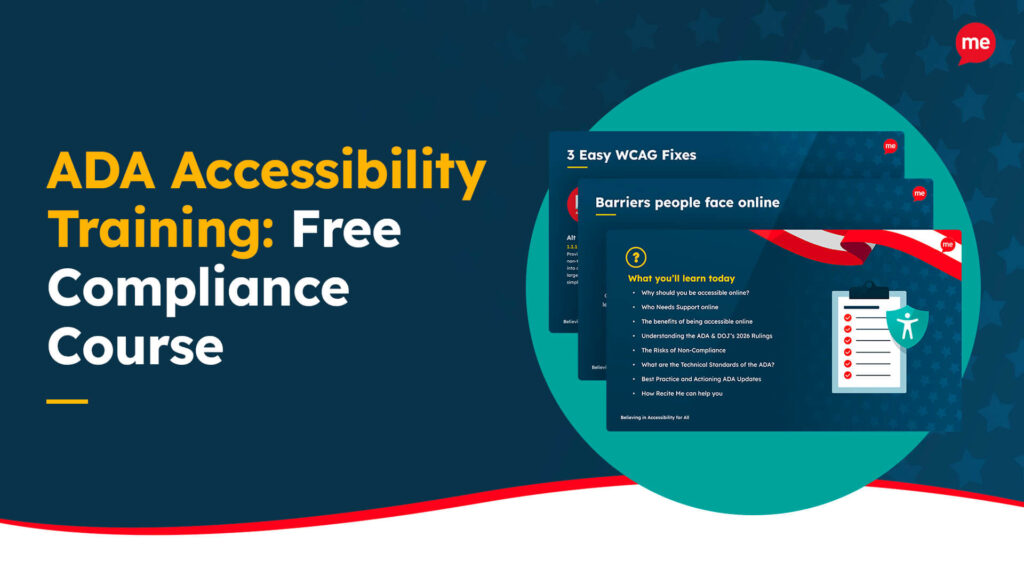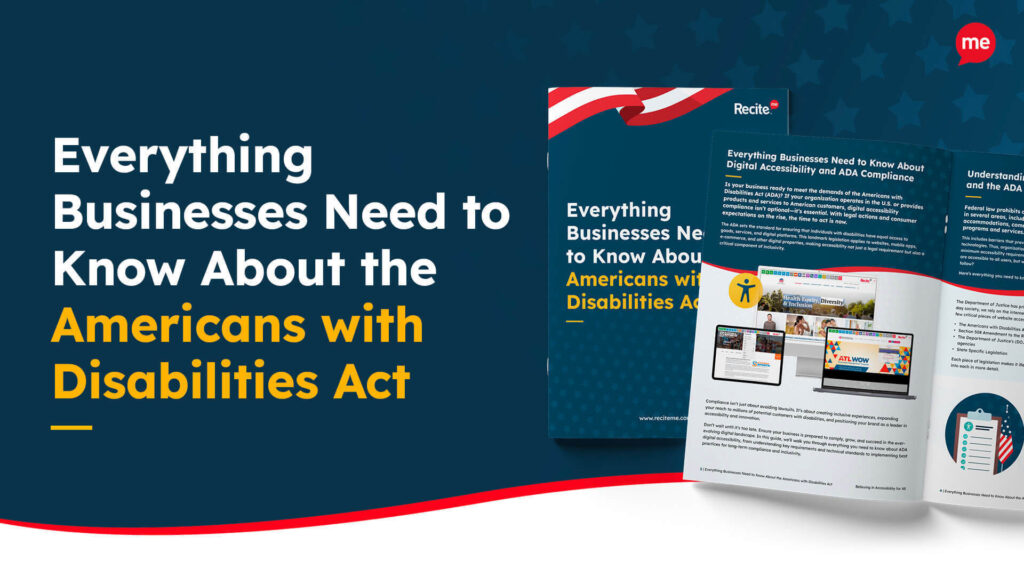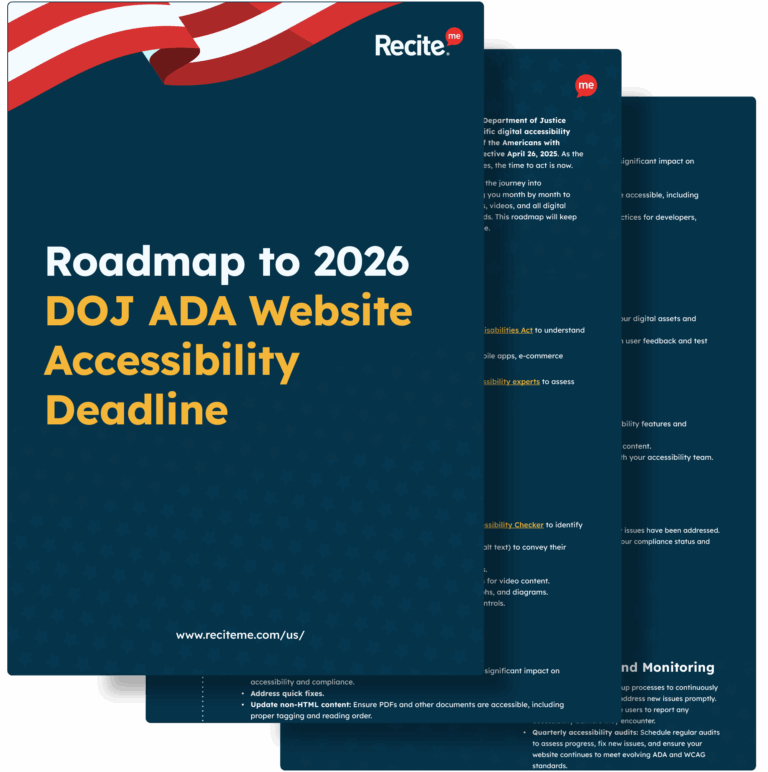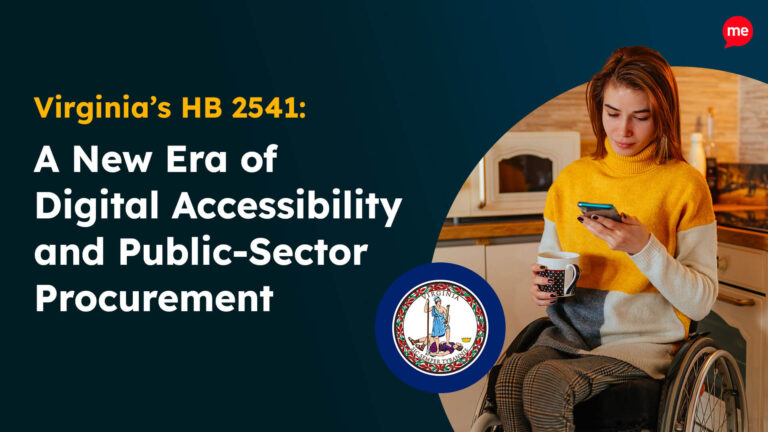Get A Free ADA Compliance Audit Of Your Website
Download NowNavigating the maze of tax regulations can be daunting – especially for small business owners. But what if there was a way to turn some of those pesky compliance costs into savings?
Enter the Americans with Disabilities Act (ADA) Tax Credit. Designed to reward small businesses for making their services more inclusive, the ADA Tax Credit helps offset the cost of making accessibility improvements, with the added bonus that it also allows you to create more inclusive online environments for your customers.
Ready to transform your approach to accessibility? Here’s everything you need to know.

What is the ADA Tax Credit?
Outlined in Section 44 of the IRS Code, the ADA Tax Credit is an incentive aimed at encouraging small businesses to comply with the Americans with Disabilities Act (ADA).
The credit covers 50% of any eligible accessibility-related expenditures over $250 made during the previous tax year. The maximum expenditure limit is $10,250, meaning the highest amount you can claim is $5,000 per year.
What is the ADA Tax Credit?
Outlined in Section 44 of the IRS Code, the ADA Tax Credit is an incentive aimed at encouraging small businesses to comply with the Americans with Disabilities Act (ADA).
The credit covers 50% of any eligible accessibility-related expenditures over $250 made during the previous tax year. The maximum expenditure limit is $10,250, meaning the highest amount you can claim is $5,000 per year.
Eligibility Criteria
To qualify for the ADA Tax Credit, your business must meet the following criteria:
- Annual gross receipts of $1 million or less, or
- Employ 30 or fewer full-time employees during the preceding tax year.
Qualifying Expenses
The credit applies to a broad range of expenses you may incur in your efforts to remove online access barriers. Examples include, but are not limited to:
- Web accessibility solutions and tools that enhance website usability for individuals with disabilities.
- Hiring sign language interpreters for meetings and events.
- Purchasing adaptive equipment for employees or customers with disabilities.
- Producing accessible formats of printed materials, such as braille, large print, or audio recordings.
- Removing architectural barriers in facilities or vehicles.
- Fees for consulting services that focus on accessibility improvements.
Want to make sure your website is compliant with the Americans with Disabilities Act? Then unlock the ADA compliance checklist now. Discover actionable steps to ensure ADA compliance, helping you avoid lawsuits and any other negative consequences of non-compliance.
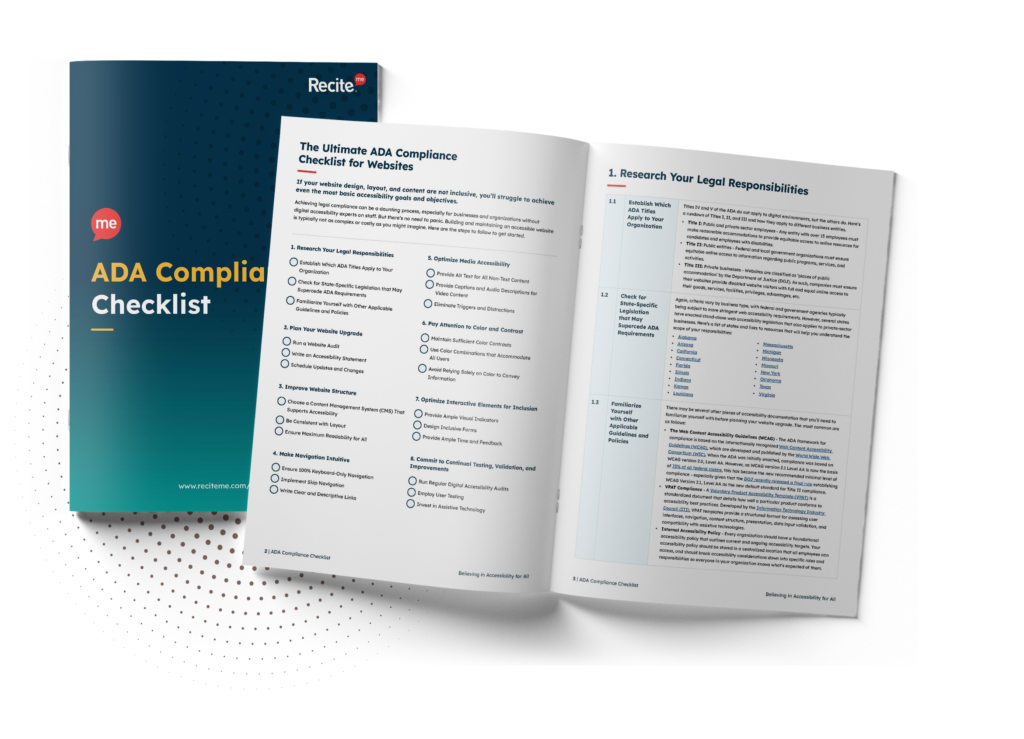
How to Claim ADA Tax Credit
Claiming the ADA Tax Credit is a straightforward process. Here are the steps to follow:
- Determine Eligibility – Confirm that your business meets the eligibility criteria.
- Calculate Your Credit – Add up your qualifying expenses, subtract the initial $250, and then calculate 50% of the remaining amount.
- Complete your application – Complete IRS Form 8826: Disabled Access Credit.
- Attach to Tax Return – Attach the completed Form 8826 to your annual tax return.
Calculating Your ADA Tax Credit
Here are a few examples of how your calculations may work in practice:
Example 1: You spend $220 hiring a sign language interpreter for a meeting.
Since the first $250 does not count toward eligible expenditure, you would not receive ADA Tax Credit for this expense.
Example 2: You spend $4,850 on website accessibility improvements by making homepage modifications, updating your webpage format and hierarchy, and providing live chat services.
Subtract the non-deductible $250 to get $4,600. You can claim 50% of this amount, which equals $2,300 in tax credit.
Example 3: You spend $14,000 on assistive technology and screen reader solutions.
Again, you subtract the initial $250, leaving $13,750. However, since the maximum expenditure limit is $10,250, you can only claim 50% of $10,000, resulting in a $5,000 credit.
Common ADA Tax Credit Mistakes and How to Avoid Them
Here are the three most common mistakes businesses make with ADA Tax Credits and some advice on how to avoid them.

- Incorrect Calculations – Ensure you subtract the initial $250 and apply the 50% rate only to the remaining qualifying amount, which can be no more than $10,000.
- Documentation Errors – The IRS may ask for proof of your expenditure. So, always keep detailed records of accessibility-related invoices and payments, and consult with a tax professional to ensure the accurate completion of Form 8826.
- Overlooking Eligibility – You may no longer meet the financial or employee-based criteria as your business grows, so it’s best to double-check your business’s eligibility criteria each tax year to avoid disqualification.
The Benefits of Enhanced Accessibility Beyond Receiving Tax Credit
The primary goal of the ADA Tax Credit is to reduce the financial burden on small businesses making efforts to make their products and services more accessible. However, the advantages don’t stop there, as there are several additional bottom-line boosting advantages:
- Increased market reach – 1 in 4 Americans has a disability that can make accessing information online challenging. So, making accessibility improvements grants you access to an additional 25% market share.
- Increased revenue – The annual spending power of Americans with disabilities equates to half a trillion dollars in disposable income (American Institutes for Research). For companies selling to a global market, this figure is estimated to be as high as $8 trillion (The Valuable 500).
- Improved brand reputation – Modern-day consumers are becoming increasingly conscious in their buying habits, with 52% considering a company’s values when making a purchase (Forbes). Being more inclusive therefore makes your company a more appealing option to non-disabled consumers, too.
- Improved internal morale – Working for a company that cares about the needs of others instills a sense of pride, making it easier for you to stand out as an employer of choice, build stakeholder confidence, and attract new investors.
- Reduced legal risk – ADA compliance is not optional, and the consequences for being found in breach can be severe. Statutory damages start at $55,000 for a first violation and rise to $110,000 for subsequent violations. And that’s without considering compensatory damages, attorney fees, and remediation costs. You can learn more about mitigating the risk of ADA web lawsuits here.
Do you actually need to get ADA compliant?
ADA compliance is mandatory for the vast majority of organizations, with only a few small businesses being exempt. Here’s what is expected for public and private organizations:
Public Sector Bodies
In December 2022, the US Department of Justice (DOJ) issued a Notice of Proposed Rulemaking to update ADA Title II regulations, explicitly extending federal accessibility standards to government websites and mobile applications.
Key compliance deadlines in the proposal are:
- April 24, 2026: All government agencies serving populations above 50,000 must be ADA compliant.
- April 26, 2027: All government agencies serving populations less than 50,000 must be ADA compliant.
These deadlines are designed to give public entities time to audit, remediate, and establish ongoing monitoring processes for digital accessibility. You can use our ADA roadmap to prepare in advance for the upcoming deadline.
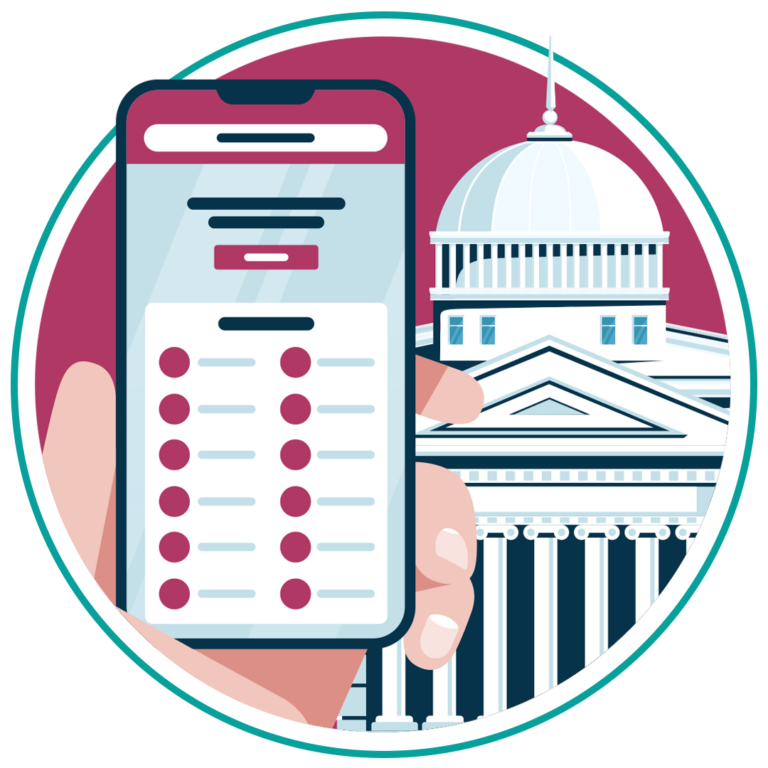
Private Organizations
Under Title III, private businesses must make their public accommodations accessible to people with disabilities. This ensures that everyone can get access to the products, services, and information they need.

Public accommodations can refer to both physical and digtial accessibility, including:
- Physical: Entrances, seating, restrooms, and parking must meet ADA Standards.
- Digital: Websites, mobile apps, online booking/e-commerce systems, and digital documents (PDFs, videos) should conform to WCAG 2.1 AA.
Title III of the ADA is already enforceable, so it’s imperative to target full WCAG 2.1 AA remediation as soon as possible to reduce legal risk.
Get a free automated ADA compliance audit of your website. This audit will highlight compliance violations and provide the recommendations needed to meet ADA compliance standards.
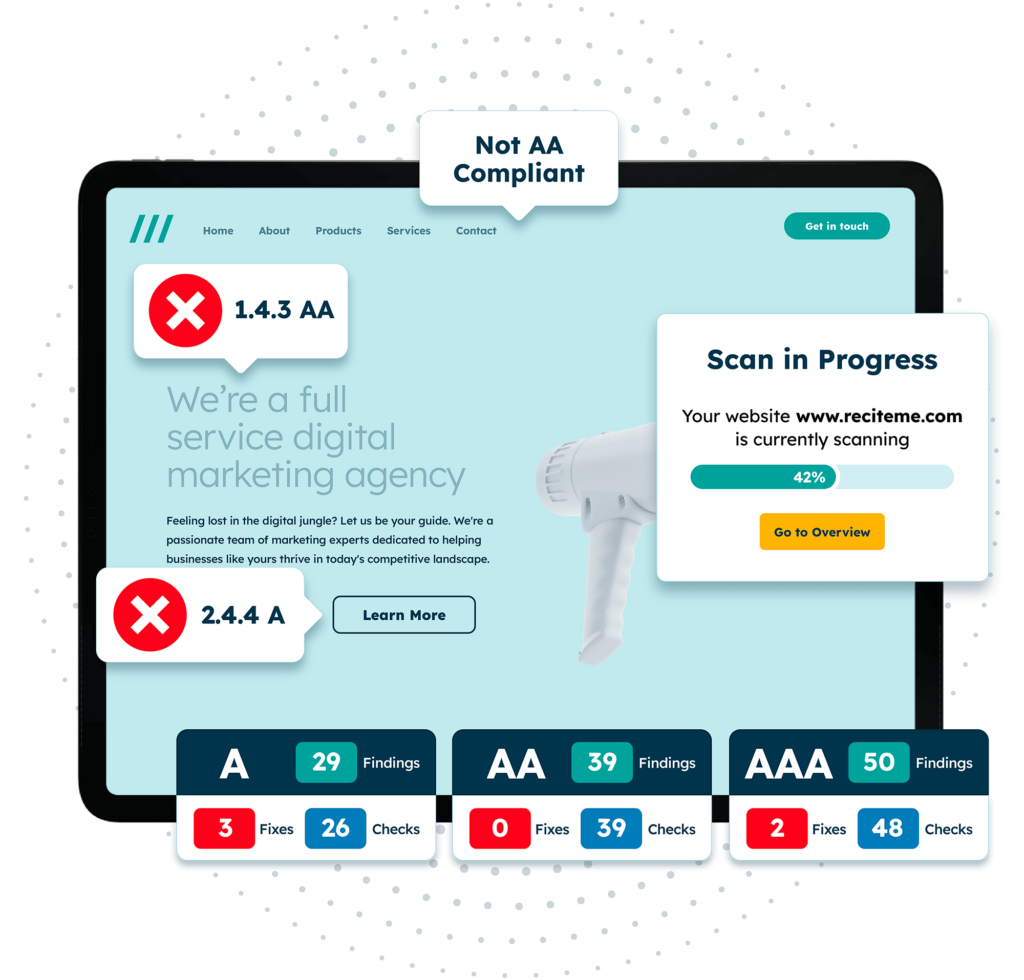
The verdict: Apply for ADA assistance today!
The need for businesses and websites to achieve ADA compliance is more important than ever in the United States. Fortunately, the ADA Tax Credit makes the process far more affordable by offsetting the cost of accessibility improvements. With a simple application and clear eligibility criteria, it’s an easy way to stretch your compliance budget further, especially when investing in tools like the Recite Me Accessibility Checker.
ADA Tax Credit FAQs
Let’s wrap up with a handy list of FAQs to cover any lingering questions you may have about the ADA Tax Credit and how it works.
Tax deductions for ordinary business expenses like travel, office supplies, and advertising directly reduce the amount of tax you owe at the end of the financial year in which they are incurred. Conversely, credits like the ADA Tax Credit reduce the amount of tax you owe later – in this case, the following year.
If your business doesn’t qualify for the federal ADA Tax Credit, it’s still worth speaking to your tax professional to identify other opportunities. The following states have stand-alone web accessibility legislation that supersede ADA provisions, and might offer State-level programs that you may qualify for:
Yes, you can apply the ADA tax credit to expenditures made every year, provided the accessibility improvements you make are eligible.
No. However, if your credit amount exceeds the amount of taxes that you owe, you can roll the unused portion of your credit forward to the following year.
Yes. The Recite Me Accessibility Checker and the Recite Me Toolbar both actively work to remove online access barriers in line with ADA provisions. So, expenditures on our suite of accessibility-on-demand tools are eligible expenses under the ADA Tax Credit.
Need more help becoming ADA compliant?
The following resources are packed full of actionable tips and expert advice for making your digital content compliant with the Americans with Disabilities Act:
Free ADA Accessibility Training
Take the first step to ADA compliance by completing our training course.
Free ADA Accessibility Guide
Ensure your organization is meeting the requirements for ADA compliance.

